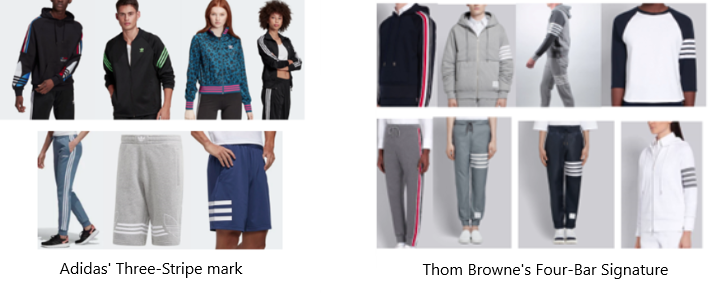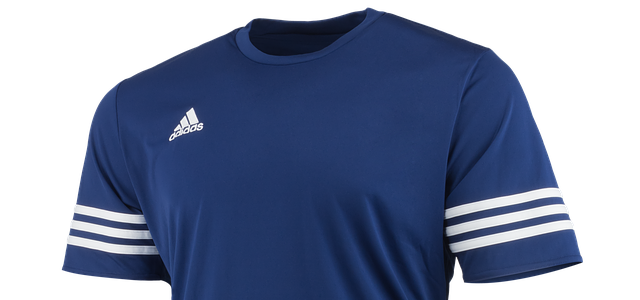 A jury in federal court in New York found fashion designer Thom Browne’s company did not infringe or dilute Adidas’ Three-Stripe trademark by selling “tailored sportswear” with four horizontal stripes.
A jury in federal court in New York found fashion designer Thom Browne’s company did not infringe or dilute Adidas’ Three-Stripe trademark by selling “tailored sportswear” with four horizontal stripes.
The backstory
Adidas is known as “The Brand with the Three Stripes.”
Thom Browne designs luxury clothing through his global company Thom Browne Inc.
Thom Browne’s designs frequently feature stripes. One pattern is “Grosgrain Signature,” which involves red, white, and blue stripes.
In about 2005, some of Thom Browne’s designs used a “Three-Bar Signature” – three parallel equally-wide stripes. After Adidas complained, Browne agreed not to use the “Three-Bar Signature.”
Browne debuted a “Four-Bar Signature” in 2008 that was the same as the “Three-Bar signature” except with an additional stripe. In 2010, Browne started selling sportswear with the Four-Bar Signature, including sweatpants, hoodies, and leggings.
Adidas claims to have learned about the Four-Bar Signature about eight years later in February 2018, from a European trademark application.

The lawsuit
Adidas sued Thom Browne in June 2021 for trademark infringement, unfair competition, trademark dilution, injury to business reputation under New York law for “offering for sale and selling athletic-style apparel and footwear featuring two, three, or four parallel stripes in a manner that is confusingly similar to Adidas’s Three-Stripe Mark.”
One of Thom Browne’s defenses was: “purchasers of Thom Browne’s apparel and footwear are highly sophisticated. There has been no actual confusion between Thom Browne’s goods and Adidas’ goods.”
Another defense was that the Four-Bar Signature did not dilute adidas’ Three-Stripe mark because other companies also used stripes on footwear and Thom Browne used the Four-Bar Signature “very differently” from how Adidas uses the Three-Stripe mark.
A third defense, and perhaps the most important, was that Thom Browne and Adidas are not competitors. Thom Browne positioned its apparel and footwear as “high-end, luxury items sold in boutiques and high-end retailers” and noted that “Adidas’ apparel and footwear are sold to consumers at a fraction of the price.”
The trial
On January 3, 2023, the case went to trial on two issues: trademark infringement and dilution.
Adidas’ attorney argued in opening that the number of stripes did not matter because consumers would mistakenly associate Thom Browne’s clothing with Adidas’. To suggest that Thom Browne and Adidas are competitors, Adidas’ attorney said that the Four-Bar Signature “was a targeted attempt by Thom Browne to grow their sportswear business.”
Thom Browne’s counsel argued that Adidas’ and Thom Browne’s customers are different: “No one’s going to purchase a Thom Browne $800 pair of sweatpants and think it’s Adidas.” Thom Browne’s attorney also suggested that Adidas did not object to Thom Browne’s Four-Bar Signature for 10 years, and only after Thom Browne’s sportswear sales increased.
Thom Browne himself testified that he had always been involved in sports, and that the idea for Three-Bar Signature was from Ivy League varsity sweaters, and the company switched to the Four-Bar Signature because it “looked the best and stayed true to the original inspiration.” Browne described the clothing as “tailored sportswear.”
On January 12, 2023 the jury returned a verdict in Thom Browne’s favor in less than two hours.
Commentary
The verdict indicates that a rights holder must know who the competition is. Adidas claimed Thom Browne was a direct competitor in sportswear and athletic footwear. The jury essentially found that, even though both produce sportswear and footwear with stripes, the audience was different. The Thom Browne customer wants to make an entirely different statement with sportswear than the Adidas customer. The target market mattered more than the category.
The jury’s finding that Thom Browne’s Four-Bar Signature did not dilute Adidas’ Three-Stripe mark indicates the jury felt that an Adidas consumer would not be confused as to the sportswear’s origin. The jurors, like the general public, were more likely to be Adidas customers than Thom Browne customers.
One would be remiss without mentioning the trial’s “David versus Goliath” aspect. Part of Thom Browne’s strategy was to suggest that the lawsuit was about Adidas imposing its girth on a much smaller designer. Because every litigant needs an emotional hook to be successful at trial, this time-tested strategy worked as intended.
Written by Jeffrey S. Bazinet, Esq., Founder, BAZINET LAW, PC.











